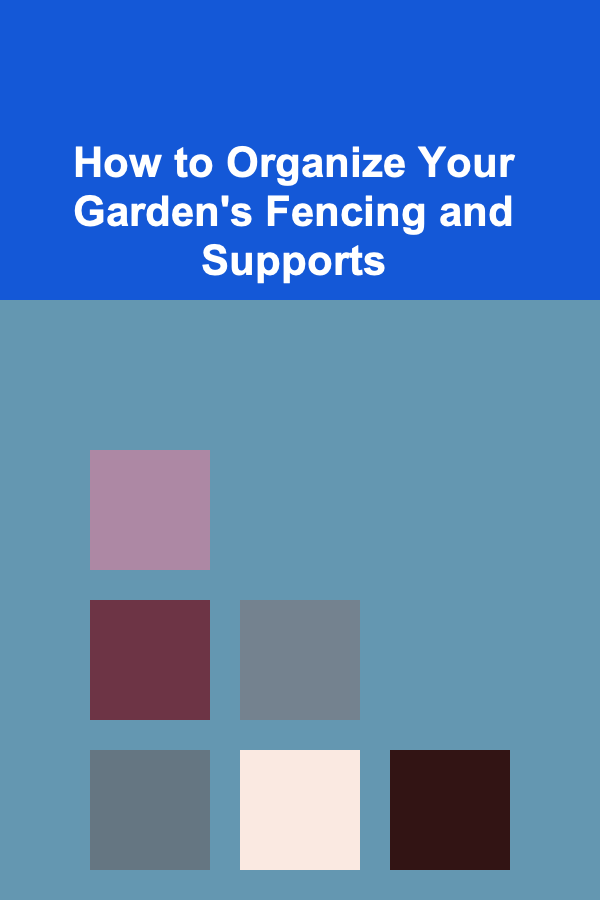
How to Organize Your Garden's Fencing and Supports
ebook include PDF & Audio bundle (Micro Guide)
$12.99$8.99
Limited Time Offer! Order within the next:

Gardening is a rewarding endeavor that connects us with nature, offering both aesthetic beauty and the pleasure of growing our own food. However, to create an effective gardening space, proper organization is key---especially when it comes to fencing and support structures. Fencing not only protects your plants from pests and animals but also delineates spaces within your garden. On the other hand, supports are essential for helping certain plants grow to their full potential. This comprehensive guide will explore how to organize your garden's fencing and supports effectively, ensuring a functional and beautiful outdoor space.
Understanding the Purpose of Fencing
1. Protection
Fencing serves as a barrier against wildlife, including deer, rabbits, and other critters that may view your garden as an all-you-can-eat buffet. Properly installed fencing can deter these unwanted guests and reduce damage to your plants.
2. Security
A well-organized fence provides security, especially if you have valuable plants or equipment in your garden. It minimizes the risk of theft and vandalism.
3. Aesthetic Appeal
Fencing can enhance the visual appeal of your garden. With various styles available, you can choose something that complements your landscape design.
4. Space Definition
Fencing helps to clearly define the boundaries of your garden, creating distinct areas for different types of plants, pathways, and even seating arrangements.
Recognizing the multi-faceted role of fencing will help you make informed decisions about its placement and type.
Types of Fencing Options
1. Wooden Fencing
Wooden fences offer a classic look and can be customized easily. They can come in various styles, such as picket, panel, or lattice.
Pros:
- Aesthetic appeal
- Customizable
- Natural material
Cons:
- Requires regular maintenance (e.g., staining, sealing)
- Can be susceptible to rot
2. Chain Link Fencing
Chain link fencing is durable and offers a transparent barrier that allows sunlight through.
Pros:
- Low maintenance
- Long-lasting
- Cost-effective
Cons:
- Limited aesthetic appeal
- Doesn't provide privacy
3. Vinyl Fencing
Vinyl fences mimic the look of wood while being more durable and lower maintenance.
Pros:
- Weather-resistant
- Easy to clean
- Various colors and styles available
Cons:
- Higher initial cost
- May become brittle over time
4. Wire Fencing
Wire fencing is often used for temporary solutions or to protect specific areas. It is commonly used for keeping smaller animals out.
Pros:
- Affordable
- Lightweight
- Easy to install
Cons:
- Less sturdy than other options
- Limited aesthetics
5. Natural Fencing
Hedges, shrubs, and living fences provide natural barriers that can serve multiple functions, such as providing habitat for beneficial insects.
Pros:
- Environmentally friendly
- Can improve biodiversity
- Aesthetic value
Cons:
- Takes time to establish
- Requires care and maintenance
Selecting the right type of fencing depends on your specific needs and the characteristics of your garden.
Choosing the Right Fencing Material
1. Assessing Durability
Consider how long you want your fencing to last. Some materials like vinyl and metal are more durable than wood.
2. Local Climate
Choose materials appropriate for your local climate. For example, treated wood may be necessary in humid areas to prevent rot.
3. Budget
Evaluate your budget for both initial installation and ongoing maintenance costs. Some materials might have a higher upfront cost but offer savings in the long run due to reduced maintenance.
4. Aesthetic Preference
Select materials that complement your garden style. Rustic wooden fences may suit cottage gardens, while sleek vinyl or metal may fit modern designs.
5. Environmental Considerations
If sustainability is important to you, consider eco-friendly materials such as reclaimed wood or bamboo.
Making an informed decision about materials will ensure that your fencing meets both functional and aesthetic needs.
Planning Your Garden Layout
1. Zoning Your Garden
Divide your garden into zones based on plant types, sunlight exposure, and watering needs. Use fencing to separate areas for vegetables, flowers, and herbs.
2. Pathways and Access Points
Design pathways that allow easy access to all parts of the garden. Ensure gates are strategically placed for convenience.
3. Consider Growth Patterns
When planning your layout, account for the growth patterns of your plants. Taller plants should be situated where they won't shade shorter ones.
4. Sunlight Exposure
Ensure that your garden layout maximizes sunlight exposure. Position taller fences or structures along the northern edge of the garden to minimize shading.
5. Future Expansion
Consider leaving space for future expansion or additional plants. A flexible layout will accommodate changes over time.
Taking the time to plan your garden layout will facilitate better organization of both fencing and support systems.
Organizing Support Structures
1. Types of Supports
- Stakes: Used for individual plants needing assistance, such as tomatoes.
- Cages: Provide a sturdy structure for climbing plants like peppers and cucumbers.
- Trellises: Ideal for climbing plants, trellises can add vertical interest and save ground space.
2. Placement Strategies
- Proximity to Plants: Ensure supports are placed close to the plants they are meant to assist without disturbing their root systems.
- Orientation: Align supports to maximize sunlight access. For instance, an east-west orientation may work best for sun-loving climbers.
3. Stability Considerations
Ensure that your supports are stable enough to withstand wind and the weight of mature plants. Use durable materials like heavy-duty stakes or galvanized wire.
4. Maintenance Access
Position supports so that they don't hinder access to watering and harvesting. Open paths around supports make maintenance easier.
Proper organization of support structures will lead to healthier plants and a more efficient gardening process.
Incorporating Trellises and Arbors
1. Functional Uses
Trellises and arbors can serve multiple functions, including providing support for climbing plants, creating shade, and enhancing visual appeal.
2. Design Options
- Freestanding Trellises: These can be placed throughout the garden for added beauty and functionality.
- Arbors: Typically located at entrances or pathways, arbors can create stunning focal points.
3. Material Selection
Choose materials that complement your garden's aesthetic. Wood, metal, and even PVC are popular choices depending on your style and budget.
4. Plant Selection
Select plants that will thrive on trellises and arbors. Climbing roses, sweet peas, and jasmine are excellent options that provide both beauty and fragrance.
Integrating trellises and arbors enhances the organization of your garden while adding structural interest.
Using Natural Supports
1. Utilizing Existing Trees
Encourage vines and climbing plants to grow up existing trees for natural support. Ensure that the tree can handle the extra weight without being harmed.
2. Bamboo Poles
Use bamboo poles as natural stakes for supporting plants. Bamboo is lightweight yet strong, making it an excellent choice for temporary or permanent supports.
3. Fallen Branches
Repurpose fallen branches or logs to create rustic support systems. This can integrate with your garden theme while being environmentally friendly.
4. Interplanting
Consider interplanting with naturally supportive species. For example, planting sunflowers alongside beans gives the beans a tall structure to climb.
Utilizing natural supports not only enhances organization but also promotes sustainability in gardening practices.
Maintaining Your Fencing and Supports
1. Regular Inspections
Regularly check your fencing and support structures for signs of wear, rot, rust, or damage. Address issues promptly to avoid larger problems.
2. Cleaning
Keep fences and supports clean by removing debris and dirt. This not only improves appearance but prevents mold and pest infestations.
3. Repair and Replacement
Be prepared to repair or replace sections of fencing or support structures as needed. Timely maintenance extends the lifespan of your investments.
4. Seasonal Adjustments
Adjust supports based on seasonal plant growth. As plants mature, you may need to provide additional support to prevent breakage.
By prioritizing maintenance, you ensure that your garden remains organized and aesthetically pleasing throughout its growing season.
Seasonal Considerations for Fencing and Supports
1. Winter Preparations
Before winter sets in, inspect fences and supports for stability. Remove any plants that won't survive freezing temperatures to prevent damage.
2. Spring Setup
As spring arrives, begin setting up your supports and reinforcing your fences. Ensure everything is ready before planting begins.
3. Summer Monitoring
During the growing season, monitor your supports closely. Many plants grow rapidly, requiring adjustments to their supports throughout the summer.
4. Fall Cleanup
At the end of the growing season, take down any damaged supports and clean the area. Store removable fencing properly to prolong its life.
Considering seasonal changes will enable you to adapt your fencing and supports to meet the needs of your plants effectively.
Troubleshooting Common Issues
1. Leaning or Collapsing Supports
If supports lean or collapse under weight, assess their installation. Reinforce with additional stakes or use sturdier materials.
2. Pest Damage
Inspect fencing for signs of pest damage. Regular maintenance and monitoring will help you catch issues early.
3. Rust and Rot
Address any rust on metal supports or rot on wood promptly. Repaint or treat surfaces to prolong their life.
4. Inadequate Height
If certain plants cannot reach support, consider adjusting the height of stakes or installing taller trellises.
Being proactive in troubleshooting common issues will help maintain the efficiency and aesthetics of your gardening setup.
Conclusion
Organizing your garden's fencing and supports is crucial for creating a thriving, productive gardening space. By understanding the purpose of fencing, choosing the right materials, and thoughtfully planning your layout, you can enhance both the function and beauty of your garden.
Remember that the journey of gardening is about patience and learning. Through continuous observation and maintenance, you'll establish a flourishing environment where both plants and gardeners can thrive. Embrace the art of organization in your garden, and watch as your efforts blossom into a stunning and harmonious outdoor sanctuary.

How to Maximize Small Closet Space with Smart Solutions
Read More
How to Organize a Family Puzzle Challenge
Read More
How to Use a Digital Inventory App for Your Luxury Collection
Read More
The Comprehensive Guide to Graphic Design: Best Practices and Tools for a Successful Career as a Specialist
Read More
How to Start a Thriving Career in Blockchain
Read More
Baking for Special Occasions: A Comprehensive Guide
Read MoreOther Products

How to Maximize Small Closet Space with Smart Solutions
Read More
How to Organize a Family Puzzle Challenge
Read More
How to Use a Digital Inventory App for Your Luxury Collection
Read More
The Comprehensive Guide to Graphic Design: Best Practices and Tools for a Successful Career as a Specialist
Read More
How to Start a Thriving Career in Blockchain
Read More